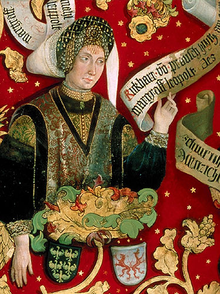Leopold I. (Austria)

Leopold I , the illustrious / serene (* around 940; † July 10, 994 in Würzburg ) also called Luitpold , from the Babenberg family , was Margrave of Austria from 976 to 994.
Life
Leopold was a count in the Bavarian Donaugau and appears as a loyal follower of Otto I as early as the 960s. A privilege of Emperor Otto I to the Roman Church of February 13, 962 is used as his first documentary mention. In it, among other witnesses, his predecessor Burchard and also a certain Liupo are named. Liupo is a diminutive of Liutpold . Apart from the later Margrave Leopold, no other bearer of this name comes into consideration at this time. Even after the uprising of Heinrich the Quarrel of Bavaria in 976 against Emperor Otto II , he continued to be emperor and was appointed margrave of an area in the east, today's Austrian heartland, in place of a certain Burkhard . On July 21, 976, he was first referred to as Margrave, marchio Liutpalus . He probably resided in Pöchlarn , but maybe already in Melk , like his successors. The margraviate then stretched from Erlabach , a few kilometers east of the Enns , in the west to the Wienerwald in the east; In the north, the Danube valley was joined by the valleys on the lower reaches of the tributaries ( Krems and Kamp ) and the Wagram , in the south the Mark reached as far as the mountainous region. In 991 the area in the east was extended to the Fischa .
Leopold died on July 10, 994 in Würzburg after an assassination attempt on his cousin Heinrich from the Schweinfurt line. Both were invited to the Kilians Mass on July 8th by the Würzburg bishop. An arrow intended for his cousin hit him and mortally wounded him.
Leopold is the first at least halfway comprehensible historical ruler of Austria. The thousandth anniversary of its establishment was therefore celebrated in 1976 under the title Thousand Years of Austria - just like the anniversary of the " Ostarrîchi " certificate twenty years later .
Although he is not mentioned by his descendant Otto von Freising (whose Babenberger chronicle begins with Leopold's son Adalbert ), he is still considered the progenitor of the ruling house of the Babenbergs, which shaped Austria significantly, if not created. Its descent from the Franconian (older) Babenbergers (Popponen), as Otto von Freising claims two hundred years later (became known from the Babenberg uprising at the beginning of the 10th century), has not been proven, but it is also not completely absurd.
children
Leopold married Richarda (also Richwarda, Richwardis or Rikchard). She was probably a sister or half-sister of Count Marchward I. von Eppenstein and the daughter of Count Ernst IV. Von Sualafeldgau from the family of the Ernste . This is also reinforced by the naming of her second son, Ernst. Leopold had eight children with her.
- Heinrich I , was Margrave of Austria from 994 to 1018 as the successor to Leopold I.
- Judith
- Ernst , was Duke of Swabia from 1012 to 1015 , married to Gisela, daughter of Duke Hermann of Swabia
- Poppo was Archbishop of Trier from 1016 to 1047
- Adalbert , was Margrave of Austria from 1018 to 1055 and successor to his brother Heinrich I.
- Luitpold I , was Archbishop of Mainz from 1051 to 1059 .
- Kunigunde
- Hemma, married to Count Rapoto von Dießen
- Christine, recluse in a monastery in Trier
reception
By the imperial resolution of Franz Joseph I of February 28, 1863 Leopold I was added to the list of the "most famous warlords and generals of Austria worthy of perpetual emulation" , in whose honor and memory there was also a life-size statue in the general hall of that time The newly established Imperial and Royal Court Weapons Museum (today: Heeresgeschichtliches Museum Wien) was built. The statue was created in 1868 from Carrara marble by the sculptor Carl Kundmann and was dedicated by Emperor Franz Joseph himself.
Individual evidence
- ↑ European Family Tables , New Series, Volume I .: The German States. Panel 39; Verlag JA Stargardt, Marburg, 1980
- ↑ Johann Christoph Allmayer-Beck : The Army History Museum Vienna. The museum and its representative rooms . Kiesel Verlag, Salzburg 1981, ISBN 3-7023-0113-5 , p. 29
literature
- Karl Lechner: The Babenbergers: "Margraves and Dukes of Austria 976-1246" . 6th, unchanged. Edition, Böhlau, Vienna; Cologne; Weimar 1996, ISBN 3-205-98569-9 .
- Heinrich Ritter von Zeissberg : Leopold I . In: Allgemeine Deutsche Biographie (ADB). Volume 18, Duncker & Humblot, Leipzig 1883, pp. 379-381.
- Walter Koch: Leopold I .. In: New German Biography (NDB). Volume 14, Duncker & Humblot, Berlin 1985, ISBN 3-428-00195-8 , pp. 274 f. ( Digitized version ).
Web links
- Entry on Leopold I (Austria) in the Austria Forum (in the AEIOU Austria Lexicon )
- Entry on Leopold I (Austria) in the database of the state's memory for the history of Lower Austria ( Museum Niederösterreich )
| personal data | |
|---|---|
| SURNAME | Leopold I. |
| ALTERNATIVE NAMES | Luitpold; Liutpold; the illustrious (nickname) |
| BRIEF DESCRIPTION | Margrave of Austria from the Babenberg family |
| DATE OF BIRTH | around 940 |
| DATE OF DEATH | July 10, 994 |
| Place of death | Wurzburg |
